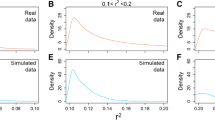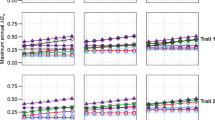Abstract
The recycling of elite inbreds (i.e., advanced cycle breeding) has led to significant genetic gains but also to a narrow gene pool in plant breeding programs. Sustained yield improvements in many crops have suggested that genetic variance is not depleted at a rate predicted by an additive genetic model. Unlike the additive model in classical quantitative genetic theory, metabolic control analysis relates the variation in a biochemical process with the genetic variation in a quantitative trait. Our objective was to determine whether metabolic control analysis is a mechanism that slows the decrease in genetic variance during advanced cycle breeding. Three cycles of advanced cycle breeding were simulated with 10, 50, or 100 quantitative trait loci (QTL) controlling a trait. In metabolic control analysis, these QTL coded for enzymes involved in a linear metabolic pathway that converted a substrate into a product. In the absence of selection, both the additive model and the metabolic control analysis model led to about a 50% reduction in genetic variance from cycle to cycle. With selection, the additive model led to a 50–58% reduction in genetic variance, but the metabolic control analysis model generally led to only a 12–54% reduction. We suggest selection in a metabolic control analysis model as a mechanism that slows the decrease in genetic variance during advanced cycle breeding. This conservation of genetic variance would allow breeders to achieve genetic gains for a longer period than expected under the additive model.
Similar content being viewed by others
References
Albe KR, Wright BE (1992) Systems analysis of the tricarboxylic acid cycle in Dictyostelium discoideum. II. Control analysis. J Biol Chem 267:3106–3114
Allard RW (1960) Principles of plant breeding. Wiley, New York
Avery PJ, Hill WG (1977) Variability in genetic parameters among small populations. Genet Res 29:193–213
Bernardo R (2002) Breeding for quantitative traits in plants. Stemma, Woodbury, Minn.
Bost B, Dillmann C, de Vienne D (1999) Fluxes and metabolic pools as model traits for quantitative genetics. I. The L-shaped distribution of gene effects. Genetics 153:2001–2012
Cheverud JM, Routman EJ (1996) Epistasis as a source of increased additive genetic variance at population bottlenecks. Evolution 50:1042–1051
Cockerham CC, Tachida H (1988) Permanency of response to selection for quantitative characters in finite population. Proc Natl Acad Sci USA 85:1563–1565
Goodnight CJ (1988) Epistasis and the effect of founder events on the additive genetic variance. Evolution 42:441–454
Groen AK, Van Roermund CWT, Vervoorn RC, Tager JM (1986) Control of gluconeogenesis in rat liver cells. Flux control coefficients of the enzymes in the gluconeogenic pathway in the absence and presence of glucagons. Biochem J 237:379–389
Hill SA, Bryce JH, Leaver CJ (1993) Control of succinate oxidation by cucumber (Cucumis sativus L.) cotyledon mitochondria. The role of the adenine-nucleotide translocator and extra-mitochodrial reactions. Planta 190:51–57
Kascer H, Burns JA (1973) The control of flux. Symp Soc Exp Biol 27:65–104
Kascer H, Burns JA (1981) The molecular basis of dominance. Genetics 97:639–666
Kearsey MJ, Farquhar AGL (1998) QTL analysis in plants: where are we now? Heredity 80:137–142
Keightley PD (1989) Models of quantitative variation of flux in metabolic pathways. Genetics 121:869–876
Keightley PD (1996) Metabolic models of selection response. J Theor Biol 182:311–316
Lynch M (1988) Design and analysis of experiments on random drift and inbreeding depression. Genetics 120:791–807
Mackay TFC (2001) The genetic architecture of quantitative traits. Annu Rev Genet 35:303–339
Otto SP, Jones CD (2000) Detecting the undetected: estimating the total number of loci underlying a quantitative trait. Genetics 156:2093–2107
Peel MD, Rasmusson DC (2000) Improvement strategy of mature plant breeding programs. Crop Sci 40:1241–1246
Poehlman JM, Sleper DA (1995) Breeding field crops, 4th edn. Iowa State University Press, Ames, Iowa, USA
Rasmusson DC, Phillips RL (1997) Plant breeding progress and genetic diversity from de novo variation and elevated epistasis. Crop Sci 37:303–310
Senior ML, Chin ECL, Lee M, Smith JSC, Stuber CW (1996) Simple sequence repeat markers developed from maize sequence found in the GENEBANK database: map construction. Crop Sci 36:1676–1683
Tanksley SD, McCouch SR (1997) Seed banks and molecular maps: unlocking genetic potential from the wild. Science 277:1063–1066
Wang J, Bernardo R (2000) Variance of marker estimates of parental contribution to F2 and BC1-derived inbreds. Crop Sci 40:659–665
Whitlock MC, Fowler K (1999) The changes in genetic and environmental variance with inbreeding in Drosophila melanogaster. Genetics 152:345–353
Whitlock MC, Phillips PC, Wade MJ (1993) Gene interaction affects the additive genetic variance in subdivided populations with migration and extinction. Evolution 47:1758–1769
Wright S (1951) The genetical structure of populations. Ann Eugen 15:323–354
Yu J, Bernardo R (2004) Changes in genetic variance during advanced cycle breeding in maize. Crop Sci (in press)
Author information
Authors and Affiliations
Corresponding author
Additional information
Communicated by H.C. Becker
Rights and permissions
About this article
Cite this article
Yu, J., Bernardo, R. Metabolic control analysis as a mechanism that conserves genetic variance during advanced cycle breeding. Theor Appl Genet 108, 1614–1619 (2004). https://doi.org/10.1007/s00122-004-1589-9
Received:
Accepted:
Published:
Issue Date:
DOI: https://doi.org/10.1007/s00122-004-1589-9




